
- Address : P.O. Box 11, Gannoruwa rd, Peradeniya, Sri Lanka
- E- Mail : director.hordi@doa.gov.lk
- Telephone :(+94) 081-2388011-12-13
- Fax :(+94) 081-2388234
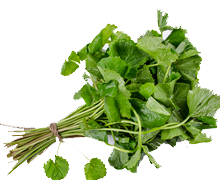
Gotukola
Centella asiatica
From the ancient Gotukola is a popular leafy vegetable among Sri Lankans. Because of its characteristic specific flavor. It has medicinal values and rich in iron. Therefore it has high market demand.
Available Types
There are two types of Gotukola based on its growth habit
- Bush type
- Vine Type
There are three types of vine type Gotukola according to the size of leaves.
- Type with large leaves (Giant Gotukola)
- Type with medium size leaves (Meerigama selection). This is the most commercially grown Gotukola type and taste is good
- Types with small leaves (WelGotukola)
Climatic requirements/ Areas suitable for cultivation
Low country wet zone is more suitable for the cultivation if irrigation facilitates are available, it can be grown in any other areas in the country
Soil
Well drained low lands are the most suitable for the cultivation. Suitable soil pH range is 6-7.
Planting Materials
Partially matured healthy runners with roots should be selected for the cultivation. Leaves are cut and removed about 2-3 days before taking planting materials.
Planting materials requirement for 100 m2
- Types with large size leaves – 5000 – 7500 runners
- Types with medium size leaves – 9000-10000 runners
Land preparation
Raised beds or sunken beds should be prepared according to the selected field to facilitate good drainage. Good textured soil with fine filth is more suitable for the growth of deep roots
Planting
Runners should be planted according to the specified spacing. Organic manure should be mixed with soil before planting. soil should be well moist when planting. Avoid drying of beds by covering with cadjans.
Spacing
- For the types with large leaves – 20 cm x 20 cm
- For the viny types with medium size leaves – 15 cm x 15 cm
Fertilizer
Both organic and inorganic fertilizers are applied for the crop
The requirement of fertilizers for 1000 m2 (1/4 ac)
- Organic manure – 1 ton
Cattle manuare, poultry manure or compost can be applied. Poultry manure is commonly applied for commercial cultivations
- Chemical fertilizer
| Time for Apply | Urea kg | TSP kg | MOP kg |
Basal – Applied two days prior to planting | 9.0 | 13.5 | 10.0 |
Top dressing – 4 weeks after planting | 9.0 | – | – |
Top dressing – after every harvesting | 4.5 | – | 1.5 |
Top dressing – at every 6 months | – | 6.5 | – |
Water supply
Irrigation is important to maintain the soil moisture. Water logging should be avoided
Weed Control
Weed should be controlled to maintain quality of harvest and to reduce spreading pest and disease.
Pest Management
Disease Management
Causal agent : This is caused by Cercospora sp.
Disease Transmission :This fungus is spread by soil and wind with infected plant parts.
Disease symptoms : Red colored or purplish brown colored spots appear on the leaf and spread throughout the leaf. Later the leaf turns the yellow color and dies.
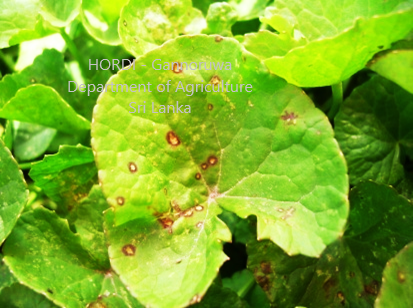 |
Control of Leaf Spot Diseases
- If the disease is spreading intensively, harvest quickly and remove the diseased plant parts and burn them.
- Provide proper nutrition for cultivation.
- Avoid unnecessary application of nitrogenous fertilizers
- Following crop rotation
- Use of healthy planting material in replanting.
Application of fungicides for commercial crops
- Apply N and K fertilizers as recommended after each harvest.Then apply a fungicide recommended as below when sprouting.
- Mancozeb 80 % WP- 32 g per 16 liter tank of water
- Chlorothalonil 75% WP- 20 g per 16 liter tank of water
- Chlorothalonil 500g/lSC – 30 ml per 16 liter tank
Apply the above fungicides again in 7 to 10 days.
Note: Continued use of the same fungicide can build resistance to by the fungus. Therefore, when applying fungicides, it is necessary to change the fungicide whenever possible. Application of fungicides should be stopped 2 weeks before harvest. Liquid inoculation can be used to control Trichoderma asperellum leaf spot disease in home gardens and organic farming.
In home gardening and organic farming
Liquid inoculation can be used to control Trichoderma asperellum leaf spot disease in home gardens and organic farming.
- Planting material treatment and planting: Trichoderma asperellum (liquid infusion (100 ml in 10 liters of water) immersed for 10 minutes and planted.
- Spray the Trichoderma asperellum solution every week after planting to thoroughly wet the plants and soil (pre-harvest period 7 days).
Note- Do not spray fungicides on lands where Trichoderma is used.
Causal agent : This is caused by Uromyces sp.
Disease Transmission : This Disease spread by wind and planting materials.
Disease symptoms : Rust spots appear on the underside of the leaves.The leaves also damage the stems and the stems become brittle.
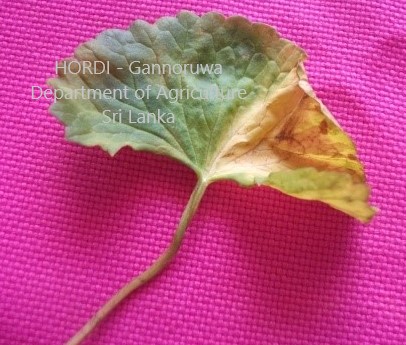 |
Control of Rust Diseases
- If the disease is spreading severely, immediately harresr and remove the diseased plant parts and burn them.
- Provide proper nutrition for cultivation.
- Avoid unnecessary application of nitrogenous fertilizers
- Following crop rotation
- Use of healthy planting material in replanting.
Application of fungicides for commercial crops
- Apply N and K fertilizers as recommended after each harvest.Then apply a fungicide recommended as below when sprouting.
- Mancozeb 80 % WP- 32 g per 16 liter tank of water
- Chlorothalonil 75% WP- 20 g per 16 liter tank of water
- Chlorothalonil 500g/lSC – 30 ml per 16 liter tank
Apply the above fungicides again in 7 to 10 days
Note: Continued use of the same fungicide can build resistance to by the fungus. Therefore, when applying fungicides, it is necessary to change the fungicide whenever possible. Application of fungicides should be stopped 2 weeks before harvest.
In home gardening and Organic farming
Liquid inoculation can be used to control Trichoderma asperellum leaf spot disease in home gardens and organic farming.
- Planting material treatment and planting: Trichoderma asperellum (liquid infusion (100 ml in 10 liters of water) immersed for 10 minutes and planted.
- Spray the Trichoderma asperellum solution every week after planting to thoroughly wet the plants and soil (pre-harvest period 7 days).
Note- Do not spray fungicides on lands where Trichoderma is used.
Causal agent : This is caused by Sclerotium spp. which live in the soil.
Disease Transmission : Spread through the infected plants or soil.
Disease symptoms:
Root and stem rotting of gotukola in some places in the cultivation area. The leaves turn to the yellow color and the plant dries up and then dies. White fungal networks can see at the base of the plant.
 |
Causal agent : This is caused by the Ralstonia solanacearum bacteria that live in the soil.
Disease Transmission : This disease spread by the infected plants, soil and irrigation water.
Disease symptoms: The leaves of infected plants turn to the brown color and then rot and the fruits die. When the base of the infected plant is cut and placed in a glass of water, bacteria can be seen oozing from the cut face in the form of white smoke.
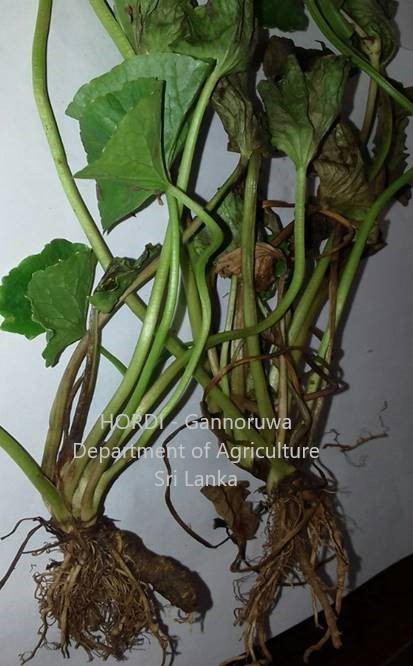 |
Disease Control
- No chemical treatments.
- Immediately remove the diseased plants from the field along with the soil.
- At the paddy fields, Do not divert water from diseased rows to rows with healthy plants
- Improvement of irrigation in the field.
- Use of organic fertilizers (especially chicken manure).
- The disease can be controlled by crop rotation (sweet potato, kangkung or mukunuwenna).
- use the uninfected planting materials when replanting
Disease Transmission : This disease is spread by aphids, sap, and cuttings.
Disease symptoms : Yellow-green spots appear on the leaves. Young leaves become irregular in shape. Leaves become smaller and also turn to yellow color. Brown spots appear on the leaves. Leaf edges and stems become purple in color. Plant stunting and mulching are reduced. Eventually the plant dies.
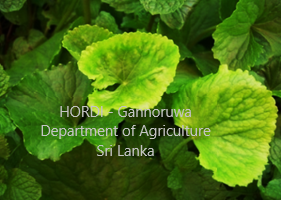 |
Disease Control
- Remove the diseased plants as soon as they are seen and burn
- Provide proper nutrition for the cultivation.
- Avoid unnecessary application of nitrogenous fertilizers
- Following crop rotation
- Use healthy planting material for replanting.
Harvesting
First harvest can be obtained within 100 days from the date of planting. According to the method of harvesting, the number of picks can be varies.
Yield
1000- 1250 kg of Gotukola harvest can be obtained from 100 m2 (1/4 ac) field. Harvesting of the crop can be continued for about 2-3 years
